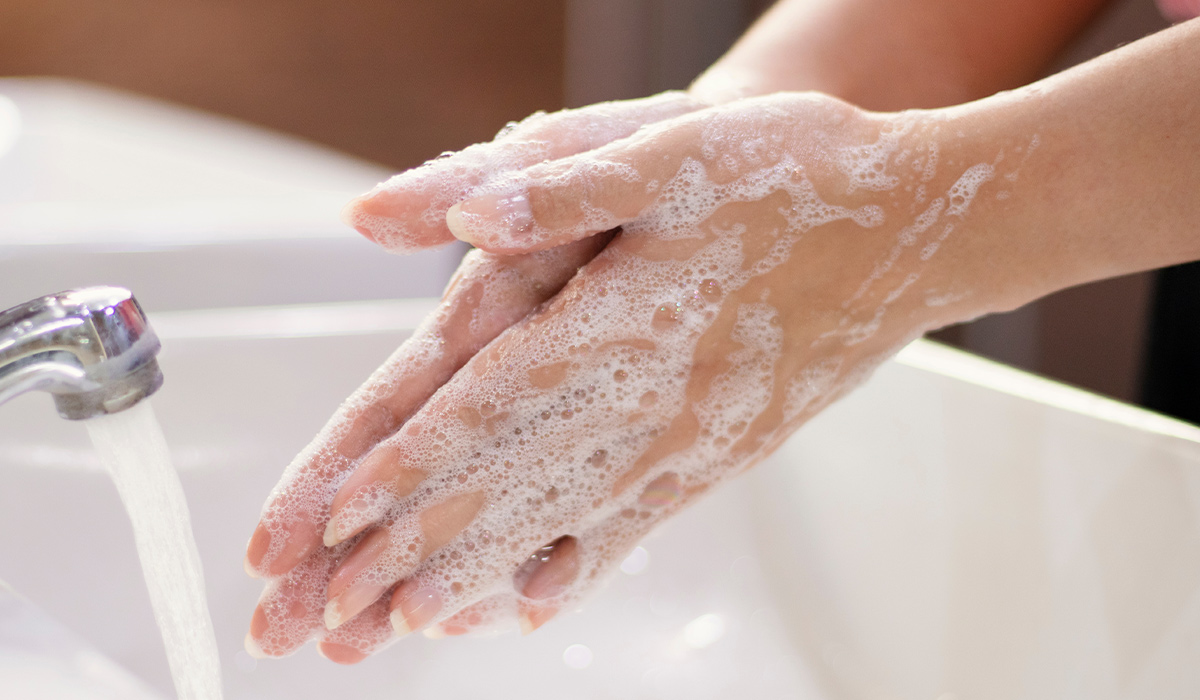Bacterial infection most often develops quickly and may result from a viral infection (e.g., develop in the case of a cold that has not been treated or treated correctly). The patient begins to complain of body weakness and feeling tired. It may be accompanied by headache or muscle pain. Usually, increased body temperature and other symptoms appear quickly, indicating that the immune system is fighting the infection.
Infection happens due to the entrance into the body and multiplication of a pathogenic microorganism. Infections can be caused by various groups of pathogens, mainly viruses, bacteria, and fungi. The condition may be asymptomatic or manifest with characteristic symptoms.
Each type of infection has different manifestations. Recognizing the condition cause of the condition is necessary because various diseases require diverse treatments.
Bacterial infections are caused by single-cell pathogens called prokaryotes![]() . To get rid of them, you need to start antibiotic therapy – symptomatic treatment will not bring any results.
. To get rid of them, you need to start antibiotic therapy – symptomatic treatment will not bring any results.
The most common bacterial diseases include:
A bacterial infection![]() develops as a result of infection with bacteria. There is no clear answer to whether it is contagious because it depends on the type of disease. You can become infected by touching infected skin where a bacterial infection develops. Being in the same room with someone suffering from a bacterial infection is not necessarily the case.
develops as a result of infection with bacteria. There is no clear answer to whether it is contagious because it depends on the type of disease. You can become infected by touching infected skin where a bacterial infection develops. Being in the same room with someone suffering from a bacterial infection is not necessarily the case.
However, bacterial infection is assumed to be much less contagious than viral infection. Viruses are transmitted through droplets and settle on objects with which the patient interacts. You can get infected by lying on the same couch with a sick person or covering yourself with a shared blanket.

Diseases caused by bacteria, also called bacterial diseases, are a group of diseases caused by the invasion of pathogens, i.e., pathogenic bacteria. Infection can occur in several ways. Some infections occur due to the excessive multiplication of bacteria that physiologically exist in the human body – forming natural microflora, such as intestinal bacteria. It appears as a result of many factors, including eating disorders, antibiotic therapy, changes in skin pH, and immune system disorders.
The list of diseases caused by bacteria is very long. Some of them are relatively mild, while some are very dangerous to health, life-threatening, and spread quickly, which may result in an epidemic. The most common human diseases caused by bacteria include:
Viral and bacterial infection![]() are two different causes of the disease. Viruses or bacteria enter the body and cause several ailments. However, viral infections
are two different causes of the disease. Viruses or bacteria enter the body and cause several ailments. However, viral infections![]() (e.g., common cold) usually have a milder course than bacterial diseases.
(e.g., common cold) usually have a milder course than bacterial diseases.
Viral infections can be cured by using home remedies for colds, staying hydrated, and resting in bed. We cannot treat a bacterial infection this way. Bacterial diseases (e.g., pneumonia or angina) develop suddenly, take away the patient's strength, and cause a high fever. A bacterial infection requires quick diagnosis and antibiotic therapy tailored to the type of microorganisms that caused the disease. Waiting out a bacterial infection may deteriorate the sick person's health.
Viruses cause:
Viral disease usually has a mild course, although the same cannot be said about childhood diseases, which can develop suddenly. Smallpox, measles, and mumps cause high temperatures and severely weaken the body, even though they are viral entities.
Viral infection usually has a milder course than bacterial infection. It may develop as a result of freezing, hypothermia, or weakening of the body. When viruses penetrate the respiratory tract or digestive system, they wreak havoc there. As a result, you feel worse very quickly. However, this does not necessarily mean high fever, chills, and night sweats. The viral infection is usually mild and resembles a cold. May cause symptoms![]() such as:
such as:
Less commonly, severe sore throat and runny nose occur with the flu. However, diarrhea is possible with this viral infection, especially in small children. In addition to fever, it is one of the causes of severe dehydration of the body, which may occur during the disease. Please remember that symptoms evolve and may vary at different stages of infection. For example, a dry cough often turns into a wet one, used to expectorate the accumulated secretions.
The disease is confirmed![]() by basic blood tests, i.e., morphology. During a viral infection, the number of white blood cells may be slightly reduced (leukopenia), while the concentration of lymphocytes may increase (lymphocytosis). However, the CRP (C-reactive protein) index, which indicates tissue damage, should not change significantly.
by basic blood tests, i.e., morphology. During a viral infection, the number of white blood cells may be slightly reduced (leukopenia), while the concentration of lymphocytes may increase (lymphocytosis). However, the CRP (C-reactive protein) index, which indicates tissue damage, should not change significantly.
Infections occur through droplets, contact with a sick person, or someone carrying the virus. Germs are in saliva, trace amounts of which are inhaled when close to another person. They can also be transferred to the mouth through hands and contaminated objects.
About one day before symptoms of the disease appear and also for 3 to 5 days during symptomatic infection. For children, spreading germs is longer – up to 10 days. In the case of severely immunocompromised patients, they may be a source of infection for many weeks.
To sum up, viral infection is characterized by:
Bacterial infection is more severe than viral infection. Usually, the disease begins suddenly and causes deterioration of well-being, high fever, wet cough, earache, or muscle pain.
Symptoms of bacterial infection![]() include:
include:

We often hear that antibiotics are the best treatment for a common cold. Unfortunately, this is an error. In many cases, infections are caused by viruses, while antibiotics only act on bacteria – depending on the type: bactericidal![]() (kill existing bacteria) or bacteriostatic
(kill existing bacteria) or bacteriostatic![]() (inhibit the growth of bacteria). Taking antibiotics
(inhibit the growth of bacteria). Taking antibiotics![]() in the case of viral infections does not make any sense and causes more harm than good – it destroys, among others, natural intestinal bacterial flora, which may cause unpleasant diarrhea or digestive disorders.
in the case of viral infections does not make any sense and causes more harm than good – it destroys, among others, natural intestinal bacterial flora, which may cause unpleasant diarrhea or digestive disorders.
Moreover, the overuse of antibiotics leads to bacteria becoming resistant to their action, as a result of which, in the event of a severe condition, they will act less effectively or practically not at all. Therefore, it is significant to distinguish between bacterial and viral infections.
After the doctor confirms the bacterial cause of the infection (primarily acute bacterial pharyngitis and tonsillitis – the so-called streptococcal tonsillitis), it is necessary to start antibiotic therapy. Phenoxymethylpenicillin is usually chosen, sometimes cephalosporins, and in case of allergies – macrolides. Depending on the drug, treatment usually involves taking the medicine for ten days, two or three times a day.
It is essential to complete the therapy – do not stop taking the antibiotic when the symptoms of inflammation disappear. Doing so may result in a rapid recurrence of the infection and the development of bacteria's resistance to a given antibiotic.
Antibiotic therapy is one of the factors that most severely damages the intestinal microflora. We all know how significant proper intestinal flora is – not only in preventing digestive problems but in the entire body's functioning. The intestinal ecosystem properly fulfills its role only when health-promoting bacteria dominate it. At the same time, potentially pathogenic bacteria and fungi (because they also inhabit the digestive tract) occur relatively small amounts.
Antibiotic therapy disturbs the proper relations between microorganisms in the intestine. This treatment is implemented when a bacterial infection develops in the body. Antibiotic therapy, while eliminating the causes of the disease – i.e., the microbes causing the illness – also removes the most desirable microbes from the intestine, belonging to the genus Lactobacillus and Bifidobacterium. Eliminating these bacteria leads to the “sterilization” of the digestive tract, which allows potentially pathogenic bacteria – more resistant to antibiotics than the health-promoting microflora – to multiply more quickly. This condition may lead to the development of serious gastrointestinal complications.
Take probiotic preparations![]() during and for a certain period after using antibiotics. It is important not to choose just any probiotic in the pharmacy but to always use preparations with scientifically proven effects to reduce post-antibiotic dysbiosis.
during and for a certain period after using antibiotics. It is important not to choose just any probiotic in the pharmacy but to always use preparations with scientifically proven effects to reduce post-antibiotic dysbiosis.
It is also important to remember the role of a properly balanced diet![]() in rebuilding microflora. Health-promoting bacteria need food so that they can multiply intensively. The basis is plant fibers that are not digestible in the digestive tract, referred to as substances with a prebiotic effect.
in rebuilding microflora. Health-promoting bacteria need food so that they can multiply intensively. The basis is plant fibers that are not digestible in the digestive tract, referred to as substances with a prebiotic effect.
A sore throat can be relieved with sprays that moisturize the throat and have anti-inflammatory and antibacterial properties, e.g., those containing benzydamine. You can also gargle with special preparations available in pharmacies, such as hydrogen peroxide. Drinking large amounts of fluids is crucial, thanks to which the mucous membranes of the nose and throat will be better moisturized.
Although cough is not typical of bacterial infections, it may occur during the disease. The procedure should then be appropriately modified, and the recommendations should include antitussive syrup (in the case of a dry cough) or expectorant syrup for a wet cough. It is significant to identify the type of cough correctly, so it is best to leave it to the doctor if in doubt.

The treatment of bacterial infection (e.g., sore throat and tonsillitis) in children is quite similar to that in adults. It is usually necessary to implement a 10-day course of antibiotics with doses appropriate to the child's body weight and age. Antibiotics in children's doses are available in syrups, often with a pleasant taste, making it easier to administer the medicine to the youngest.
It is equally important not to stop therapy too early and follow the doctor's recommendations.
If the symptoms of bacterial infection are ignored, and appropriate pharmacotherapy is not introduced, many serious complications may occur.
The most important ones include:
Prevention![]() must be adapted to the type of bacterial infection. It is also worth taking care to strengthen your natural immunity. How to do it?
must be adapted to the type of bacterial infection. It is also worth taking care to strengthen your natural immunity. How to do it?
Nutrition affects the functioning of the immune system because it is through food that we provide the body with the necessary nutrients. Therefore, a healthy diet that provides all the necessary nutrients in appropriate amounts (balanced), is low in simple sugar and is rich in vegetables and fruits is conducive to health. It is now undoubtedly known that obesity can reduce immunity. It causes chronic inflammation of the body, which loses the strength to fight dangerous microorganisms – increasing the risk of infection.
Water is a good and natural source of many valuable elements. Everyone must drink water every day – at least one and a half liters per day. Remember that even if we don't feel like drinking, we should drink water because thirst only appears when the body is partially dehydrated.
Contrary to appearances, our body likes exercise. Sport has a positive effect not only on muscles, bones, and joints but also on the cardiovascular, respiratory, and nervous systems. It also improves immunity. WHO recommends 150 minutes of moderate or 75 minutes of intense physical activity a week for an adult.
Positive effects can be brought by just 20 minutes of daily, intense walking. Regular and adapted physical activity also stimulates the secretion of happiness hormones and helps reduce anxiety and stress. If we practice sports intensively, let's not forget about rest. After each exercise, regeneration is necessary. Bathing, stretching, and massage help you regain strength.
We should supplement the deficiencies of vitamins or other elements in the body only if we lack them or are at risk of their deficiency. If we are healthy and eat a balanced diet, swallowing handfuls of dietary supplements will not make us healthier.
Vaccinations protect us against dangerous, even fatal, infectious diseases by “teaching the immune system how to fight a given microorganism. Thanks to immunization, contact with a microorganism (specifically its antigen) stimulates the immune system cells to produce specific antibodies against it – which ensures long-term protection after vaccination. In case of contact with the same microorganism, the cells of the immune system have been taught how to fight it and now know what specific antibodies to produce. Thanks to this, the disease does not develop or has a milder course. One of the goals of the vaccine is also to protect against complications.
Prolonged or very intense stress causes a decrease in immunity, resulting in susceptibility to many diseases.
Alcohol is not the solution because it can make stress worse. It is best to de-stress through contact with other people or physical exercise, which increases the production of endorphins (the so-called happiness hormones).
Table of Contents

Antibiotics are drugs used for a variety of ailments. Learn about the most common side effects of antibiotics and how… read more »

Discover Sore Throat Remedies for quick and effective pain relief. Many herbs and foods have healing properties. Learn how to… read more »

Strep throat is a bacterial infection that affects the throat and tonsils. Around 11 million people are infected with this… read more »

Bacterial vaginosis is a common problem for women. Learn the risk factors so you can eliminate them and protect yourself… read more »

A viral infection occurs when a virus invades the body and begins to multiply. Viruses are tiny infectious agents that… read more »

Epstein Barr Virus is a pathogen that causes infectious mononucleosis and many other diseases. Learn about the risks associated with… read more »

MRSA infection is a medical condition in which antibiotic-resistant bacteria attack the body. The infection can be asymptomatic or very… read more »

Staph infection is a common disease. How can you get infected with this bacteria? How to avoid it? Learn all… read more »

Scarlet fever is an infectious disease caused by bacteria. Infection most often occurs through droplets or contact with contaminated objects.… read more »